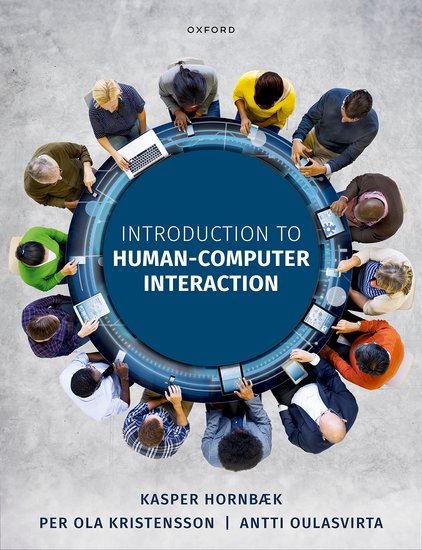
A new textbook for introductory-level HCI courses:
- 10 parts, covering the whole HCI process
- Over 200 principles and 100 examples
- 864 pages and 1.9 kgs
- Suitable for teaching students various backgrounds, including computer science, engineering, social sciences, and design
- Teaching materials (slides) available for educators via request
- Open access
Aimed at undergraduate students in computer science, design, and engineering programs, and master students in dedicated programs, this is the first comprehensive textbook for students of human-computer interaction.
While HCI is primarily a research-driven field, the book focuses not only on scientific principles of interaction, but also on the very concrete goal of designing better computing systems. The book revises and synthesizes topics that have been previously scattered across multiple books and papers, including design, engineering, empirical methods, and technology. Although it covers emerging topics like VR and AI, the book places its emphasis on the more time-enduring principles and methods. The book is open access and comes with associated materials for teachers and students, available on the book’s companion website.
Access
This is an open access book available under the terms of a CC BY-NC-ND 4.0 international licence. It is free to read on the Oxford Academic platform and offered as a free PDF download from OUP and selected open access locations.
- Hardback, paperback, e-book, and open access PDF available via OUP
- Chapter-level PDFs available here
- Physical book available via Amazon, Barnes&Noble, eBay, Blackwell’s, Waterstones, Booktopia, Thalia, Dussmann, and many others
Authors
Kasper Hornbæk is a Professor of Computer Science at the University of Copenhagen. His core research interests are in human-computer interaction, theories of interaction, user experience, and extended reality.
Per Ola Kristensson is a Professor of Interactive Systems Engineering in the Department of Engineering at the University of Cambridge and a Fellow of Trinity College, Cambridge. He leads the Intelligent Interactive Systems group, which belongs to the Engineering Design Centre. He is also a co-founder and co-director of the Centre for Human-Inspired Artificial Intelligence at the University of Cambridge.
Antti Oulasvirta is a Professor at the Department of Information and Communications Engineering at Aalto University where he leads the Computational Behaviour Lab. He is a computational cognitive scientist with an interest in predictive models of human performance in interactive computing.
Contents
I Overview of Human-Computer Interaction
1: Introduction to human-computer interaction
II Understanding People
2:Introduction to Understanding People
3:Perception
4:Motor Control
5:Cognition
6:Needs and Motivations
7:Experience
8:Collaboration
9:Communication
III User Research
10:Introduction to User Research
11:Interviews
12:Field Research
13:Survey Research
14:Unobtrusive Research
15:Representations of User Research
IV Understanding Interaction
16:Introduction to Interaction
17:Information and Control
18:Dialogue
19:Tool Use
20:Automation
21:Rationality
22:Practice
V User Interfaces
23:Introduction to User Interfaces
24:Input Devices
25:Displays
26:Interaction Techniques
27:Commands and Navigation
28:Graphical User Interfaces
29:Reality-Based Interaction
VI Design
30:Introduction to Design
31:Design Cognition
32:Design Practice
33:Design Processes
VII Engineering
34:Introduction to Engineering
35:Systems
36:Design Engineering
37:Safety and Risk
38:Software
39:Computational Representations and Models
VIII Evaluation
40:Introduction to Evaluation
41:Analytical Evaluation Methods
42:Think-aloud Studies
43:Experiments
44:Field Evaluations
IX Conclusion
45:Growing into the HCI Discipline
46:Summary: HCI’s Principles
Preface
Guidance for teachers and students; acknowledgements. PDF
Reference
Kasper Hornbæk, Per-Ola Kristensson, and Antti Oulasvirta (2025). Introduction to Human-Computer Interaction. Oxford University Press.